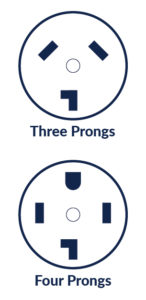How to Set Up Your Washer and Dryer
For homeowners, having a reliable washer and dryer setup is an important priority. But, if you’re upgrading to a new washer/dryer or installing one for the first time, the process of getting things working can seem like a tall order. You may be considering calling for professional electricians to get the wiring done, but it’s actually not as complex as most people think. If you’re ready to tackle the task yourself, here’s a DIY guide on how to set up your washer and dryer.
Three Prongs vs. Four Prongs
 First things first: You’ve probably noticed that washer and dryer power cords (especially dryer cords) may not look like conventional power cords for your other electrical devices. You’ll be looking at a circular outlet that is designed for either a three-pronged or four-pronged plug. Up through the mid-90’s, the three-pronged design was widely used, delivering power effectively. But in 1996, the National Electric Code was updated, mandating a switch to four-prong outlets in new homes by the year 2000. The four-prong outlet serves as a safety upgrade, as it separates ground wires and neutral wires, thereby negating the possibility for electric shocks.
First things first: You’ve probably noticed that washer and dryer power cords (especially dryer cords) may not look like conventional power cords for your other electrical devices. You’ll be looking at a circular outlet that is designed for either a three-pronged or four-pronged plug. Up through the mid-90’s, the three-pronged design was widely used, delivering power effectively. But in 1996, the National Electric Code was updated, mandating a switch to four-prong outlets in new homes by the year 2000. The four-prong outlet serves as a safety upgrade, as it separates ground wires and neutral wires, thereby negating the possibility for electric shocks.
Fortunately, dryer power cables are fairly easy to replace, so going from three prongs to four doesn’t mean you’ll have to buy an entirely new dryer. After making sure your dryer is disconnected from its power source and removing the access panel on the back of your dryer, you can remove the screws fastening the wires to the appropriate terminals and hook up the new cord, making sure the ground wire is in place and that the “hot” and neutral wires connect to the correct terminals. After that, you can replace the access panel, plug the dryer in, and test it out to ensure proper operation.
Tips to Remember
Apart from your power supply, there are some other important things to remember when you set up your washer and dryer. Make sure you’re paying attention to each of the following.
- Measure Your Space: Get a good idea of the dimensions of your space before you start moving equipment in, and you’ll save yourself considerable hassle down the line. Make sure you leave a minimum of four inches of space behind your dryer for ventilation purposes.
- Check Your Dryer Vent: Make sure you’re starting with a clean dryer vent by purchasing an inexpensive vent brush. Also, check the vent hood outdoors for any debris.
- Clear Out Your Washer Lines: While the washer is disconnected, put empty buckets under the hot and cold water outlets and let them run. This will clear out debris from valve screens. After you do this, attach the hoses to the correctly colored outlets, and then connect the drain hose.
- Make Sure Both Machines Are Level: To reduce noisy jostling, use a level to check if your washer and dryer are sitting flat on a hard, smooth surface.
All things considered, attempting to set up your washer and dryer is a good entry-level home project to try, even for novice DIY enthusiasts. With care and patience, you can accomplish this on your own and get started on laundry in no time. If you’ve got installation projects at home that require more expertise, we encourage you to get in contact with the pros at Bryant Electric Service. We’ve got more than 30 years of service under our belts, and we’re happy to get you on the right track with lighting, surge protection, smart home technology, and much more.



